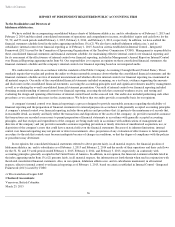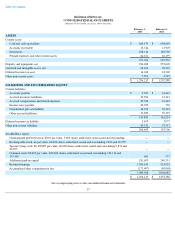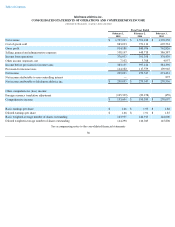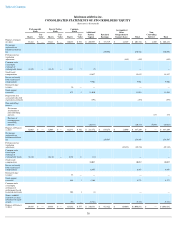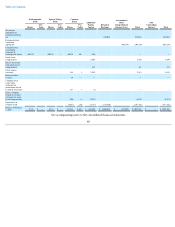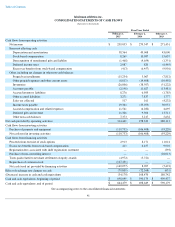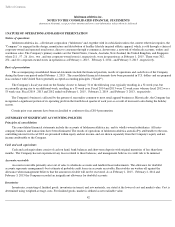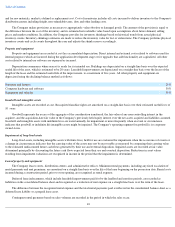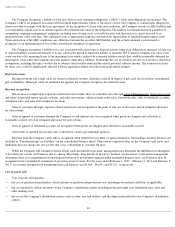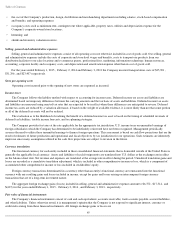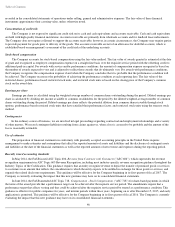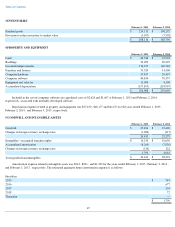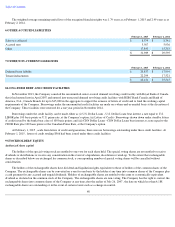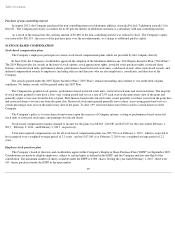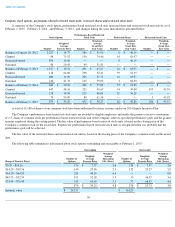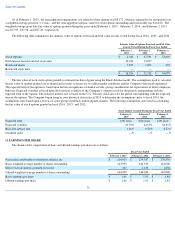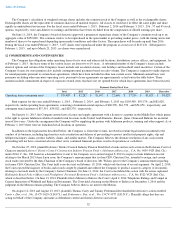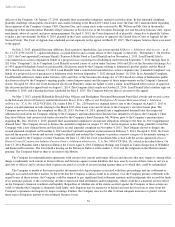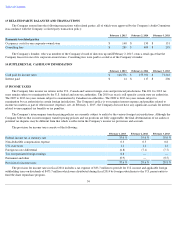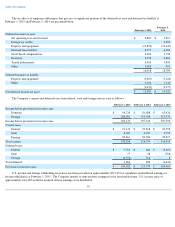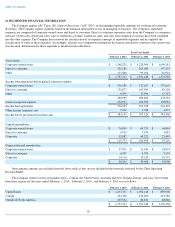Lululemon 2014 Annual Report Download - page 52
Download and view the complete annual report
Please find page 52 of the 2014 Lululemon annual report below. You can navigate through the pages in the report by either clicking on the pages listed below, or by using the keyword search tool below to find specific information within the annual report.
Table of Contents
recorded in the consolidated statements of operations under selling, general and administrative expenses. The fair value of these financial
instruments approximates their carrying value, unless otherwise noted.
Concentration of credit risk
The Company is not exposed to significant credit risk on its cash and cash equivalents and accounts receivable. Cash and cash equivalents
are held with high quality financial institutions. Accounts receivable are primarily from wholesale accounts and for landlord lease inducements.
The Company does not require collateral to support the accounts receivable; however, in certain circumstances, the Company may require parties
to provide payment for goods prior to delivery of the goods. The accounts receivable are net of an allowance for doubtful accounts, which is
established based on management's assessment of the credit risk of the underlying accounts.
Stock
-based compensation
The Company accounts for stock-
based compensation using the fair value method. The fair value of awards granted is estimated at the date
of grant and recognized as employee compensation expense on a straight-line basis over the requisite service period with the offsetting credit to
additional paid-in capital. For awards with service and/or performance conditions, the amount of compensation expense recognized is based on
the number of awards expected to vest and is adjusted to reflect those awards that do ultimately vest. For awards with performance conditions,
the Company recognizes the compensation expense if and when the Company concludes that it is probable that the performance condition will
be achieved. The Company reassesses the probability of achieving the performance condition at each reporting date. The fair value of the
restricted shares, performance-based restricted stock units, and restricted stock units is based on the closing price of the Company's common
stock on the award date.
Earnings per share
Earnings per share is calculated using the weighted-average number of common shares outstanding during the period. Diluted earnings per
share is calculated by dividing net income available to common stockholders for the period by the diluted weighted-average number of common
shares outstanding during the period. Diluted earnings per share reflects the potential dilution from common shares issuable through stock
options, performance-based restricted stock units that have satisfied their performance factor, and restricted stock units using the treasury stock
method.
Contingencies
In the ordinary course of business, we are involved in legal proceedings regarding contractual and employment relationships and a variety
of other matters. We record contingent liabilities resulting from claims against us, when a loss is assessed to be probable and the amount of the
loss is reasonably estimable.
Use of estimates
The preparation of financial statements in conformity with generally accepted accounting principles in the United States requires
management to make estimates and assumptions that affect the reported amounts of assets and liabilities and the disclosure of contingent assets
and liabilities at the date of the financial statements as well as the reported amounts of net revenue and expenses during the reporting period.
Recently issued accounting standards
In May 2014, the FASB issued ASC Topic 606, Revenue from Contracts with Customers ("ASC 606"), which supersedes the revenue
recognition requirements in ASC Topic 605 Revenue Recognition, including most industry-
specific revenue recognition guidance throughout the
Industry Topics of the Codification. This guidance requires that an entity recognize revenue to depict the transfer of promised goods or services
to customers in an amount that reflects the consideration to which the entity expects to be entitled in exchange for those goods or services, and
expands the related disclosure requirements. This guidance will be effective for the Company beginning in its first quarter of fiscal 2017. The
Company is currently evaluating the impact that this new guidance may have on its consolidated financial statements.
In June 2014, the FASB amended ASC Topic 718, Compensation - Stock Compensation ("ASC 718") for share-based payments in which
the terms of the award provide that a performance target can be achieved after the requisite service period. The amendments require that a
performance target that affects vesting and that could be achieved after the requisite service period be treated as a performance condition. This
guidance is effective for public companies for years, and interim periods within those years, beginning on or after December 15, 2015, and early
application is permitted. This guidance will be effective for the Company beginning in its first quarter of fiscal 2016. The Company is currently
evaluating the impact that this new guidance may have on its consolidated financial statements.
46


